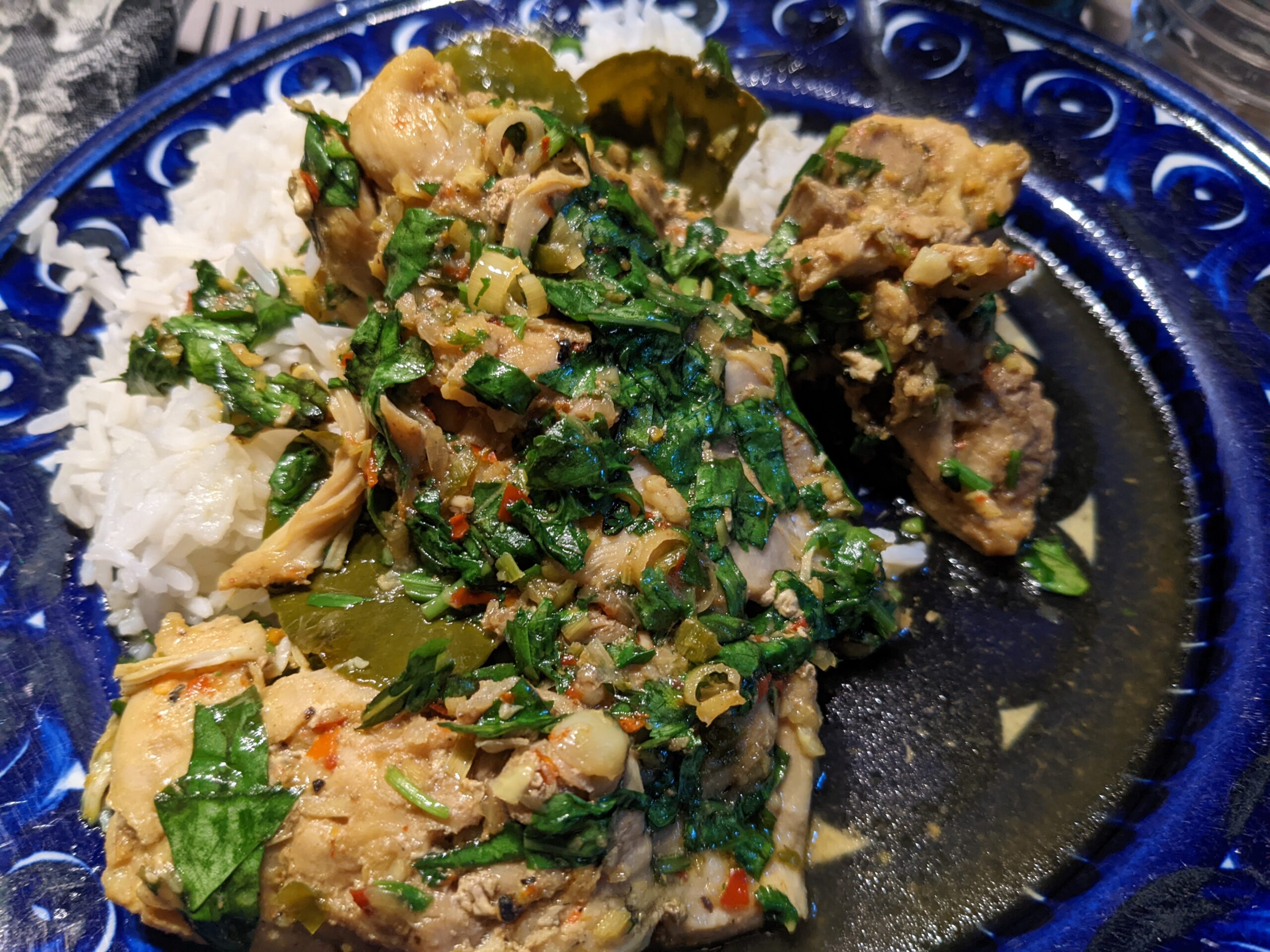Makes 4-6 servings
1-2 pieces lemongrass
1 bunch coriander (with roots if possible)
2-3 cloves garlic
a piece of fresh turmeric root
a piece of galangal (about 1TBL in volume)
2-3 shallots
1 TBL red pepper flakes
8 bird chilis
2 lbs chicken parts (I like thighs, but you can use a whole chicken)
1 TBL Thai fish sauce
3 makrut lime leaves
1 small bunch of Thai basil
1 small bunch of lemon basil
1 small bunch cilantro
1 small bunch culantro
Making Underwater Chicken requires that you have the right setup for cooking the dish: You will need a pot that’s about 12-inches wide and deep enough to hold the chicken pieces. In addition, you must have a metal bowl wide enough to fit atop the pot and make a tight seal where it meets the rim of the pot. The bowl should have a capacity a greater capacity than the pot — perhaps holding a 2 gallons of water comfortably. Take a look at the photo of my setup, below.
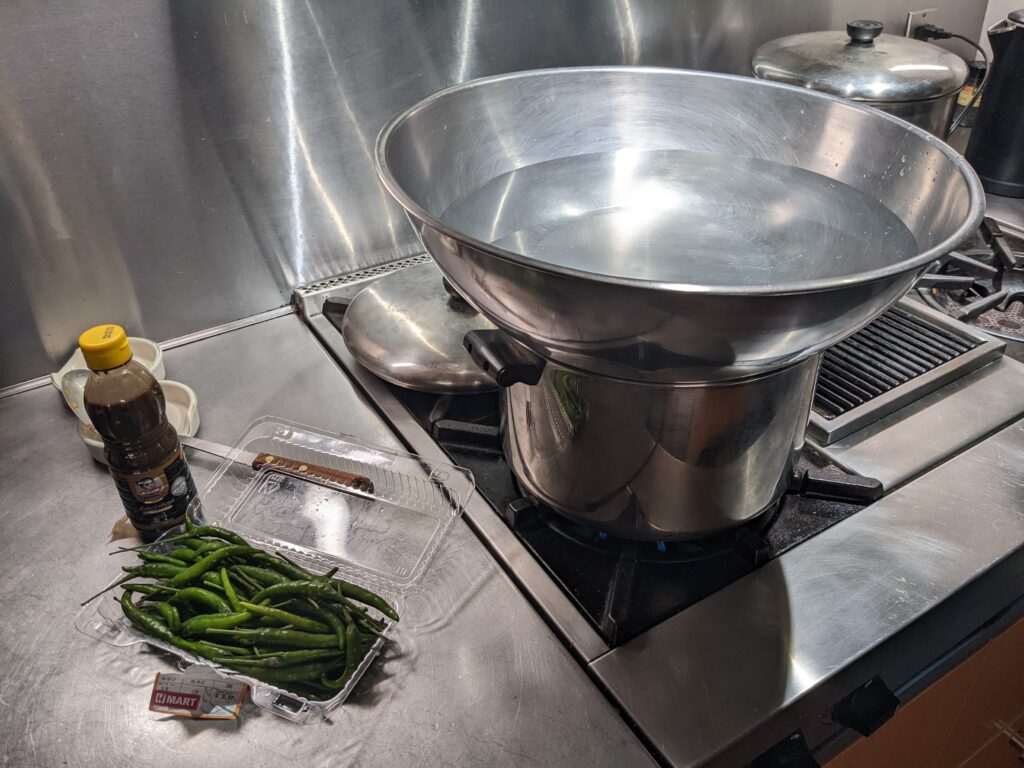
There are some important things about the ingredients that you should know. While in a perfect world you would be able to track down all the ingredients, I have to tell you that I have made this with a lot of substitutions and been incredibly happy with the results. Having said that, it was better when I had more of the right ingredients. So, here are some substitutions before you get scared away:
Missing ingredients?
For the fresh turmeric, consider using turmeric powder. No galangal: I have used ginger. Frozen galangal is available available in some Asian food markets. For the bird chilis, any other fresh hot pepper will work. I’ve used Vietnamese fish sauce plus some soy sauce when I couldn’t get Thai fish sauce. I’ve made this without the makrut lime leaves. Thai basil, has been a must-have ingredient for me, but I believe that a mix of tarragon leaves with Italian basil would probably work. Unfortunately, I haven’t been able to find lemon basil (also known as Thai lemon basil, Lao lemon basil or hoary basil) available and just leave it out; the same goes for the culantro. That sounds like a lot of substitutions but you can get an incredibly delicious result with this technique and several substitutions.
Make the paste
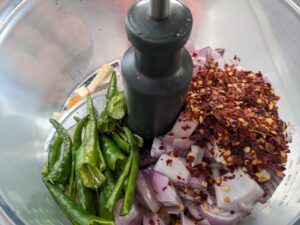
In a food processor, combine the following ingredients. The source recipe link, below, shows a video of how to make this using a mortar and pestle. I always have used a food processor with good results.
- 1½ tsp salt
- 1¼ tsp ground black pepper
- 1 TBL lemongrass (trimmed heart, cut crosswise finely)
- 1 TBL coriander root or stems
- 1½ tsp garlic (peeled, but whole is fine)
- 1 tsp fresh turmeric root (a piece of turmeric, scrubbed clean)
- 2 tsp chopped galangal
- ½ cup coarsely chopped shallots
- 1 TBL red pepper flakes
- 4 bird chilis, seeds and stems removed
- 2 TBL Thai fish sauce
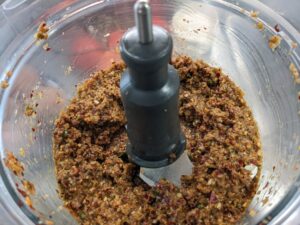
This is a quadruple recipe.
Blend all of this into a paste. Set the paste aside.
In our somewhat large food processor, it works better when I scale up the recipe (4x) and make a big batch. I separate out the portions and freeze the extras for future meals.
Cooking the dish
Remove the skin and hack the
- 2 lbs chicken parts
into smaller pieces. Typically I chop the thighs into 2-3 pieces, the breast into 3-4, legs into 2 pieces — cutting right through the bone. Your dish will have more flavor with the chicken skin left on, but it will be fattier — too fatty for my taste.
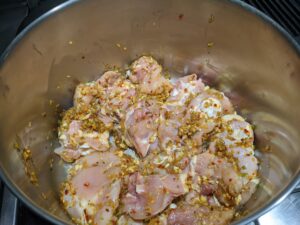
In a 12-inch wide soup pot, mix the chicken parts and the paste. Stir everything in the pot together and place a large metal bowl, as described above, on top of the pot.
Put about 4 quarts of cold tap water into the metal bowl, turn on the burner (medium, reducing to medium-low after 5 minutes) and pay attention. In about 20-25 minutes the water in the top pot will show signs that it’s getting lots of little bubbles forming. This might happen sooner and if that’s the case, you need to bail out some of the water and replace it with more cold water.
After 25 minutes of cooking, bail out most of the water from the bowl, carefully take away the bowl, dumping out the water. In the pot stir in
- 3 makrut lime leaves, torn into pieces
- 1 TBL lemongrass (white part, cut finely across the grain)
- 4 more bird peppers (whole), if you like
Stir the mixture, replace the bowl, fill with 4 quarts of cold water again, and cook for another 20-25 minutes. Bail out the water, remove the bowl and discard the rest of the water. Stir into the pot
- 2 cups of chopped mixed herbs (ideally equal parts of Thai basil, lemon basil, cilantro and culantro)
Serve immediately with cooked white rice.
How does this work?
If you’re like me, you’re probably very curious about this odd cooking method. There is an outstanding description of the technique, along with yet another recipe for this to be found on the Hot Thai Kitchen site. If you want to see the making of the recipe, beginning to end, consider watching this video (in Thai, unfortunately), from which I learned quite a bit, even though I do not speak Thai.
From a recipe by MeeKao on trueid.net.

